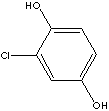| CAS
NO. |
615-67-8 |

|
| EINECS
NO. |
210-442-8 |
| FORMULA |
C6H3(OH)2Cl |
| MOL
WT. |
144.56 |
|
H.S.
CODE
|
|
|
TOXICITY
|
|
| SYNONYMS |
2-Chloro-1,4-benzenediol; 2-Chlorohydroquinone;
|
| 1,4-Dihydroxy-2-chlorobenzene;
Chloroquinol; Monochlorohydroquinone; 2-Chloro-1,4-dihydroxybenzene; Chlorhydrochinon
(German); Clorohidroquinona (Spanish); Chlorohydroquinone
(French); |
| SMILES |
|
|
CLASSIFICATION
|
|
|
PHYSICAL
AND CHEMICAL PROPERTIES
|
| PHYSICAL
STATE |
White
to off-white crystals
|
| MELTING
POINT |
101
- 102 C |
| BOILING
POINT |
263
C |
| SPECIFIC
GRAVITY |
|
| SOLUBILITY
IN WATER |
Soluble |
| pH |
|
| VAPOR
DENSITY |
|
|
AUTOIGNITION
|
|
|
NFPA
RATINGS
|
Health:
2; Flammability: 1; Reactivity: 0 |
|
REFRACTIVE
INDEX
|
|
| FLASH
POINT |
|
| STABILITY |
Stable
under ordinary conditions. |
| GENERAL
DESCRIPTION AND APPLICATIONS |
| There
are three isomeric compounds of dihydroxybenzene molecule
structure, which all have traditional names respectively.
The ortho (1,2) isomer is called catechol (Also known
as catechin; pyrocatechol; pyrocatechuic acid), which
forms clear crystals used as a photographic developer
in solution and as a starting material to produce synthetic
catecholamines which have important physiological effects
as neurotransmitters and hormonesany (such as epinephrine,
adrenaline, norepinephrine, and dopamine). The meta
(1,3) isomer is resorcinol (also known as resorcin),
which forms clear needle crystals used in the production
of diazo dyes and plasticizers. It is produced by sulfonating
benzene with fuming sulfuric acid and fusing the resulting
benzenedisulfonic acid with caustic soda. Resorcinol
is used in resins as an UV absorber. It is used in manufacturing
fluorescent and leather dyes and adhesives. Reaction
with formaldehyde produces resins (resorcinol formaldehyde
resins) used to make rayon and nylon. It is used as
a pharmaceutical to treat acne and other greasy skin
conditions in combination with other acne treatments
such as sulfur. It is used as an anti-dandruff agent
in shampoo and sunscreen cosmetics. It is also used
as a chemical intermediate to synthesis pharmaceuticals
and other organic compounds. The para (1,4) isomer is
hydroquinone (also known as quinol), which forms clear
prisms used as a photographic reducer and developer
(except in color film). It is formed in large quantities
by chemical reduction of benzoquinone. This compound
is a general-purpose inhibitor, stabilizer, antioxidant,
and intermediate. One of the major uses of hydroquinone
is as an intermediate to make other inhibitors, stabilizers,
antioxidants, agricultural chemicals, and dyes. Resorcinol
and its derivatives are used in resins as UV absorbers.
They are used in manufacturing fluorescent and leather
dyes and adhesives (resorcinol formaldehyde resins).
They are used as pharmaceuticals to treat acne and other
greasy skin conditions in combination with other acne
treatments such as sulfur. They are used as an anti-dandruff
agent in shampoo and sunscreen cosmetics. Chlorohydroquinone
is an useful intermediate to produce developer, stabilizer, antioxidant,
medicines and other organic compounds. |
| SALES
SPECIFICATION |
|
APPEARANCE
|
White
to off-white crystals
|
|
CONTENT
|
98.0%
min |
| ASH |
0.2%
max
|
| TRANSPORTATION |
| PACKING |
25kgs
in fiber drum
|
| HAZARD
CLASS |
6.1
(Packing Group: III) |
| UN
NO. |
2761,
2811 |
| OTHER
INFORMATION |
| Hazard Symbols: XN, Risk Phrases: 21/22, Safety
Phrases: 36/37-45 |
